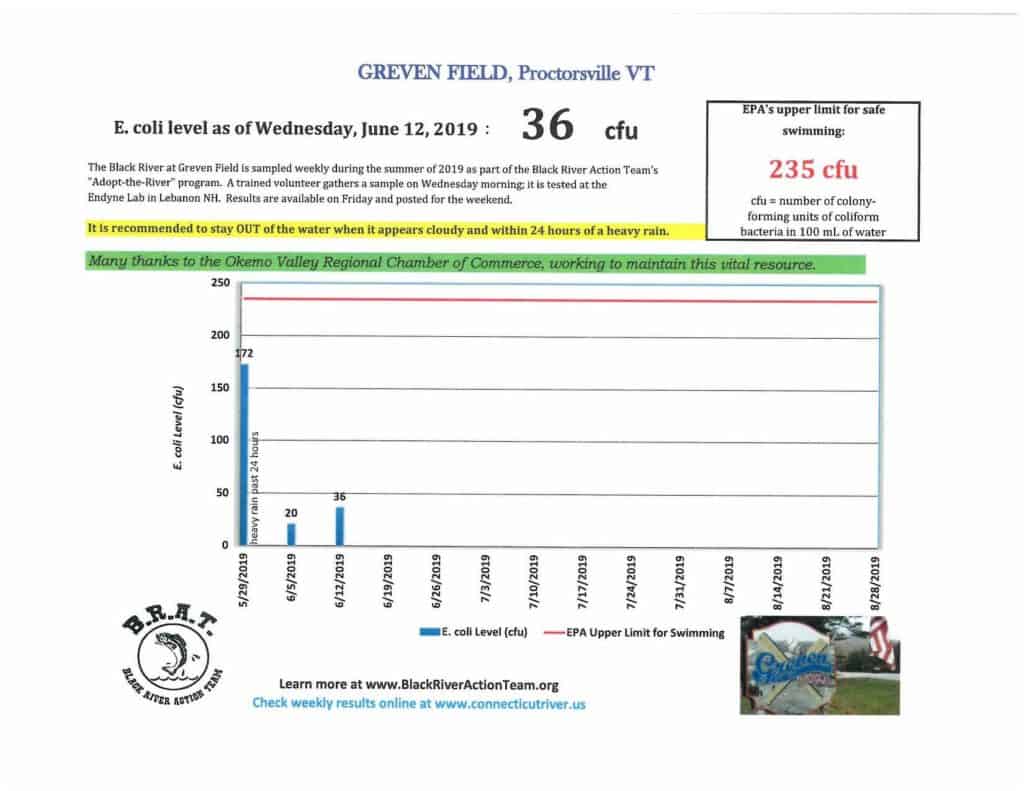REGION – From Memorial Day through Labor Day, folks want to be out and about, exploring Vermont’s waterways to keep cool, fish, paddle, and otherwise enjoy the great outdoors. We like to know that the water we come into contact with is safe, clean, and healthy. To this end, the Black River Action Team conducts ongoing sampling of several popular river and stream sites around the watershed to keep tabs on the bacteria levels in the water.
While some level of bacteria is naturally occurring in all soil and water, elevated levels of the bacterium Escherichia coli – or E. coli – may be an indication of the presence of other pathogens in water, which could have the potential to make a person or pet ill if they come into contact with enough of it through swimming or boating – or in the case of a dog, drinking. While all warm-blooded animals host a healthy level of E. coli in their gut, some strains can lead to illness such as diarrhea, vomiting, and abdominal pain.

Water samples are carefully collected every Wednesday morning by a trained BRAT volunteer and transported to the Endyne Inc. laboratory in Lebanon, N.H. for testing. Samples are incubated to get an accurate count of colony-forming units (cfu) present in the 100 mL sample. A heavy rain can wash soil, and the bacteria in it, into streams and rivers, thereby elevating the count in the water. It is recommended that people stay out of the water for 24 hours after a heavy rain, and anytime the bacteria level is at or above 235 cfu.
Charts are generated within 48 hours based on the numbers from the lab, but reflect only a “snapshot” of the water – what the bacteria level was at the exact moment and in the exact location the water was collected. By the time the charts are posted, any number of factors may have changed to alter the actual bacteria count for weekend visitors. The goal of the sampling, testing, and chart posting is to give people an overview of the long-term bacteria counts of a given site.
BRAT Director Kelly Stettner wishes to extend many thanks to all the volunteer water quality monitors, River Dippers, who commit to weekly sampling of several popular swimming and wading spots in the Black River and to the local businesses and organizations who “adopt” these spots. The annual “adoption fee” covers all the costs associated with water collection, sample testing, transportation, and chart posting every week for the entire summer at one site.
The testing sites include Buttermilk Falls in Ludlow, adopted by Okemo Mountain Resort; Cavendish Gorge in Cavendish, adopted by Green Mountain Power; the Black River at Greven Field in Cavendish, adopted by Betty McEnaney of TPW Realty; Tolles Power Dam off Maple Street in Weathersfield, testing costs donated by Endyne; and Twenty-Foot Hole on the North Branch in Reading, adopted by the Greater Upper Valley Chapter of Trout Unlimited.
The pond at the West Hill Road Rec Park is monitored for bacteria by the town of Ludlow, despite not yet being open for boating or swimming, and is adopted by Vermont Co-Pack. No chart will be posted at this site.
When visiting these or any Vermont waterway, please check the chart posted on-site to get a sense of the trends. Look for consistency in the numbers and stay out of the water for 24 hours after a heavy rain or any time it appears cloudy.
Learn more about BRAT and the River Dipper program by visiting www.BlackRiverActionTeam.org. Check all swimming holes around the region for historic as well as current conditions at the “Is It Clean?” website maintained by the Connecticut River Conservancy, www.connecticutriver.us.